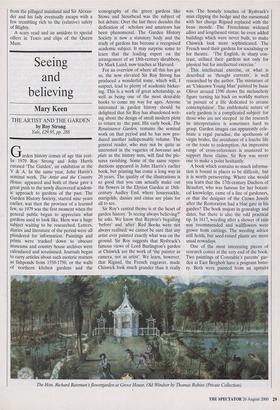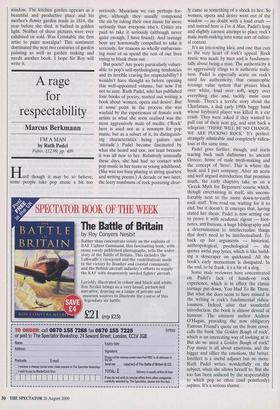Seeing and believing
Mary Keen
THE ARTIST AND THE GARDEN by Roy Strong Yale, £29.95, pp. 288 Garden history comes of age this year. In 1979 Roy Strong and John Harris curated The Garden', an exhibition at the V & A. In the same year, John Harris's seminal work, The Artist and the Country House, appeared and both of these gave a great push to the newly discovered academ- ic approach to gardens of the past. The Garden History Society, started nine years earlier, was then the province of a learned few, so 1979 was the first moment when the general public began to appreciate what gardens used to look like. Here was a huge subject waiting to be researched. Letters, diaries and literature of the period were all plundered for information. Paintings and prints were tracked down to obscure museums and country house archives were calendared and scrutinised. Journals began to carry articles about such esoteric matters as fishponds from 1550-1750, or the walls of northern kitchen gardens and the iconography of the green gardens like Stowe and Stourhead was the subject of hot debate. Over the last three decades the dedication of scholars and amateurs has been phenomenal. The Garden History Society is now a statutory body and the study of gardens has become a recognised academic subject. It may surprise some to learn that the leading expert on the arrangement of an 18th-century shrubbery, Dr Mark Laird, now teaches at Harvard.
For an overview of where all this has got us, the now elevated Sir Roy Strong has produced a wonderful tome, which will, I suspect, lead to plenty of academic bicker- ing. This is a work of great scholarship, as well as being one of the most desirable books to come my way for ages. Anyone interested in garden history should be delighted that Sir Roy has abandoned writ- ing about the design of small modern plots to return to the past. His early book, The Renaissance Garden, remains the seminal work on that period and he has now pro- duced another indispensable volume. The general reader, who may not be quite as interested in the vagaries of berceaux and plats as the history nuts, will find the pic- tures ravishing. Some of the same repro- ductions appeared in John Harris's earlier book, but printing has come a long way in 20 years. The quality of the illustrations is so good that you can actually make out the flowers in the Elysian Garden at 18th- century Audley End, where honeysuckle, marigolds, daisies and cistus are plain for all to see.
Sir Roy's central theme is at the heart of garden history. 'Is seeing always believing?' he asks. We know that Repton's beguiling `before' and 'after' Red Books were not always realised: we cannot be sure that any artist ever painted exactly what was on the ground. Sir Roy suggests that Rysbrack's famous views of Lord Burlington's garden at Chiswick are the work of 'the painter as camera, not as artist'. We learn, however, that Rigaud, the French engraver, made Chiswick look much grander than it really was. The homely touches of Rysbrack's man clipping the hedge and the nursemaid with her charge Rigaud replaced with the beau monde. The Frenchman widened allees and lengthened vistas; he even added buildings which were never built, to make Chiswick look more sophisticated. The French used their gardens for socialising or for theatre. 'The English, in sharp con- trast, utilised their gardens not only for physical but for intellectual exercise.'
This intellectual exercise, or what is described as 'thought currents', is well researched by the author. The miniature of an 'Unknown Young Man' painted by Isaac Oliver around 1590 shows the melancholy figure turning his back on worldly matters `in pursuit of a life dedicated to arcane contemplation'. The emblematic nature of early gardens is a complicated subject: for those who are not steeped in the research its interpretation is sometimes hard to grasp. Garden images can apparently cele- brate a regal paradise, the apotheosis of virgin brides, the avoidance of a louche life or the route to redemption. An impressive range of cross-references is mustered to support these claims. Sir Roy was never one to make a point hesitantly.
A book which contains so much informa- tion is bound in places to be difficult, but it is worth persevering. Where else would you learn that the 17th-century Duchess of Beaufort, who was famous for her botani- cal knowledge, came of a line of gardeners, or that the designer of the Crown Jewels after the Restoration had a blue gate in his garden? The book majors in genealogy and dates, but there is also the odd practical tip. In 1617, weeding after a shower of rain was recommended and wallflowers were grown from cuttings. The weeding advice still holds, but seed-raised plants are more usual nowadays.
One of the most interesting pieces of research comes at the very end of the book. Two paintings of Constable's parents' gar- den at East Bergholt have a poignant histo- ry. Both were painted from an upstairs The Hon. Richard Bateman's flowergarden at Grove House, Old Windsor by Thomas Robins (Private Collection) window. The kitchen garden appears as a beautiful and productive place and his mother's flower garden made in 1814, the year before she died, is bathed in golden light. Neither of these pictures were ever exhibited or sold. Was Constable the first artist to paint nostalgia? This sentiment dominated the next two centuries of garden painting as well as garden making and needs another book. I hope Sir Roy will write it.



























































 Previous page
Previous page